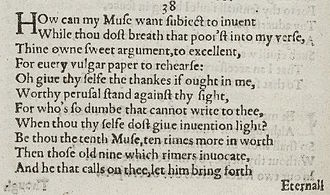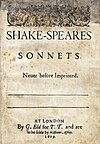Sonnet 38: Difference between revisions
m Robot sorting 'poetry-stub' to 'UK-poem-stub' |
EIGHTCLOUDS (talk | contribs) removed Category:British poems using HotCat |
||
| (30 intermediate revisions by 20 users not shown) | |||
| Line 1: | Line 1: | ||
{{Use dmy dates|date=April 2022}} |
|||
{| align=right border=1 cellpadding=2 cellspacing=2 style="margin-left:1em" style="margin-bottom:1em" |
|||
{{Sonnet|38|Sonnet 38 1609.jpg|The first eleven lines of Sonnet 38 in the 1609 Quarto| |
|||
|- align=left style="background:lightyellow" |
|||
| ⚫ | |||
|'''''Sonnet 38''''' <p> |
|||
| ⚫ | |||
| ⚫ | |||
| ⚫ | |||
| ⚫ | |||
| ⚫ | |||
| ⚫ | |||
| ⚫ | |||
| ⚫ | |||
| ⚫ | |||
| ⚫ | |||
| ⚫ | |||
| ⚫ | |||
| ⚫ | |||
|source=<ref>{{cite book |title=The Works of Shakespeare: Sonnets |editor-first=C[harles] Knox |editor-last=Pooler |series=The Arden Shakespeare [1st series] |location=London |publisher=Methuen & Company |date=1918 |url=https://archive.org/details/sonnetseditedbyc00shakuoft |oclc=4770201}}</ref> |
|||
| ⚫ | |||
'''Sonnet 38''' is one of [[The Sonnets|154 sonnets]] written by the English playwright and poet [[William Shakespeare]]. It is a member of the [[The Sonnets#Fair Youth|Fair Youth]] sequence, in which the lyric subject expresses its love towards a young man. |
|||
'''by William Shakespeare'''<br> |
|||
==Structure== |
|||
| ⚫ | |||
Sonnet 38 is an English or Shakespearean sonnet, composed of three [[quatrain]]s and a final rhyming [[couplet]]. It follows the form's typical [[rhyme scheme]], ABAB CDCD EFEF GG. Like other Shakespearean sonnets the poem is composed in a type of poetic [[Metre (poetry)|metre]] known as [[iambic pentameter]] based on five pairs of metrically weak/strong syllabic positions. The final line exemplifies a regular iambic pentameter: |
|||
| ⚫ | |||
| ⚫ | |||
| ⚫ | |||
<pre style="border:none;background-color:transparent;margin-left:1em"> |
|||
| ⚫ | |||
× / × / × / × / × / |
|||
| ⚫ | |||
The pain be mine, but thine shall be the praise. (38.14) |
|||
| ⚫ | |||
</pre> |
|||
| ⚫ | |||
:/ = ''ictus'', a metrically strong syllabic position. × = ''nonictus''. |
|||
==Notes== |
|||
| ⚫ | |||
{{reflist}} |
|||
| ⚫ | |||
| ⚫ | |||
| ⚫ | |||
==Further reading== |
|||
| ⚫ | |||
| ⚫ | |||
| ⚫ | |||
<br> |
|||
| ⚫ | |||
==See also== |
|||
| ⚫ | |||
==External links== |
==External links== |
||
*[http://www.shakespeares-sonnets.com/xxxviiicomm.htm Analysis] |
*[http://www.shakespeares-sonnets.com/xxxviiicomm.htm Analysis] |
||
*[http://www.cliffsnotes.com/WileyCDA/LitNote/id-169,pageNum-41.html CliffsNotes] |
|||
{{ |
{{Shakespeare}} |
||
| ⚫ | |||
{{DEFAULTSORT:Sonnet 038}} |
|||
{{shakespearesonnets}} |
|||
[[Category: |
[[Category:Sonnets by William Shakespeare]] |
||
| ⚫ | |||
Latest revision as of 10:58, 17 May 2024
| Sonnet 38 | |||||||
|---|---|---|---|---|---|---|---|
 The first eleven lines of Sonnet 38 in the 1609 Quarto | |||||||
| |||||||
Sonnet 38 is one of 154 sonnets written by the English playwright and poet William Shakespeare. It is a member of the Fair Youth sequence, in which the lyric subject expresses its love towards a young man.
Structure
[edit]Sonnet 38 is an English or Shakespearean sonnet, composed of three quatrains and a final rhyming couplet. It follows the form's typical rhyme scheme, ABAB CDCD EFEF GG. Like other Shakespearean sonnets the poem is composed in a type of poetic metre known as iambic pentameter based on five pairs of metrically weak/strong syllabic positions. The final line exemplifies a regular iambic pentameter:
× / × / × / × / × / The pain be mine, but thine shall be the praise. (38.14)
- / = ictus, a metrically strong syllabic position. × = nonictus.
Notes
[edit]- ^ Pooler, C[harles] Knox, ed. (1918). The Works of Shakespeare: Sonnets. The Arden Shakespeare [1st series]. London: Methuen & Company. OCLC 4770201.
Further reading
[edit]- First edition and facsimile
- Shakespeare, William (1609). Shake-speares Sonnets: Never Before Imprinted. London: Thomas Thorpe.
- Lee, Sidney, ed. (1905). Shakespeares Sonnets: Being a reproduction in facsimile of the first edition. Oxford: Clarendon Press. OCLC 458829162.
- Variorum editions
- Alden, Raymond Macdonald, ed. (1916). The Sonnets of Shakespeare. Boston: Houghton Mifflin Harcourt. OCLC 234756.
- Rollins, Hyder Edward, ed. (1944). A New Variorum Edition of Shakespeare: The Sonnets [2 Volumes]. Philadelphia: J. B. Lippincott & Co. OCLC 6028485. — Volume I and Volume II at the Internet Archive
- Modern critical editions
- Atkins, Carl D., ed. (2007). Shakespeare's Sonnets: With Three Hundred Years of Commentary. Madison: Fairleigh Dickinson University Press. ISBN 978-0-8386-4163-7. OCLC 86090499.
- Booth, Stephen, ed. (2000) [1st ed. 1977]. Shakespeare's Sonnets (Rev. ed.). New Haven: Yale Nota Bene. ISBN 0-300-01959-9. OCLC 2968040.
- Burrow, Colin, ed. (2002). The Complete Sonnets and Poems. The Oxford Shakespeare. Oxford: Oxford University Press. ISBN 978-0192819338. OCLC 48532938.
- Duncan-Jones, Katherine, ed. (2010) [1st ed. 1997]. Shakespeare's Sonnets. Arden Shakespeare, third series (Rev. ed.). London: Bloomsbury. ISBN 978-1-4080-1797-5. OCLC 755065951. — 1st edition at the Internet Archive
- Evans, G. Blakemore, ed. (1996). The Sonnets. The New Cambridge Shakespeare. Cambridge: Cambridge University Press. ISBN 978-0521294034. OCLC 32272082.
- Kerrigan, John, ed. (1995) [1st ed. 1986]. The Sonnets ; and, A Lover's Complaint. New Penguin Shakespeare (Rev. ed.). Penguin Books. ISBN 0-14-070732-8. OCLC 15018446.
- Mowat, Barbara A.; Werstine, Paul, eds. (2006). Shakespeare's Sonnets & Poems. Folger Shakespeare Library. New York: Washington Square Press. ISBN 978-0743273282. OCLC 64594469.
- Orgel, Stephen, ed. (2001). The Sonnets. The Pelican Shakespeare (Rev. ed.). New York: Penguin Books. ISBN 978-0140714531. OCLC 46683809.
- Vendler, Helen, ed. (1997). The Art of Shakespeare's Sonnets. Cambridge, Massachusetts: The Belknap Press of Harvard University Press. ISBN 0-674-63712-7. OCLC 36806589.


